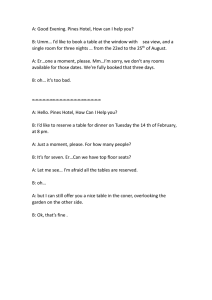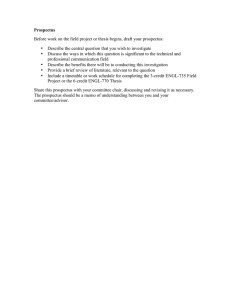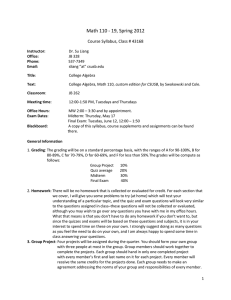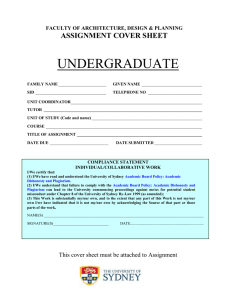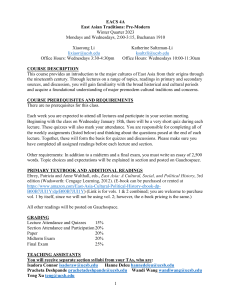History of Chinese Thought ASH 4602 (CRN TBA) 3 Credits
advertisement
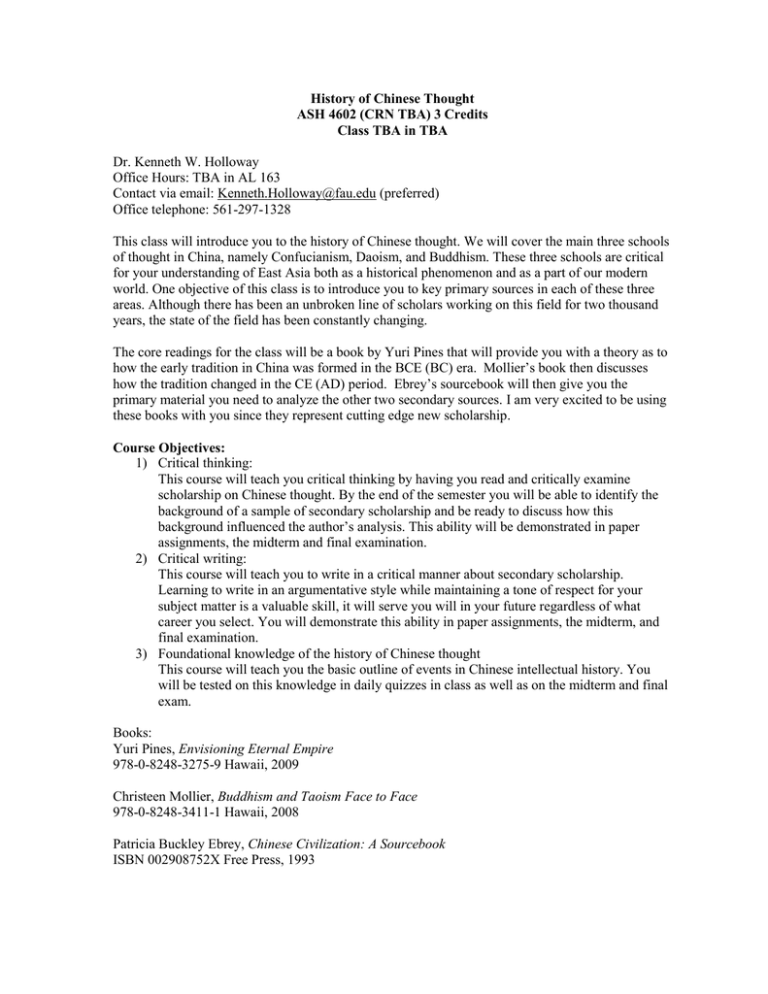
History of Chinese Thought ASH 4602 (CRN TBA) 3 Credits Class TBA in TBA Dr. Kenneth W. Holloway Office Hours: TBA in AL 163 Contact via email: Kenneth.Holloway@fau.edu (preferred) Office telephone: 561-297-1328 This class will introduce you to the history of Chinese thought. We will cover the main three schools of thought in China, namely Confucianism, Daoism, and Buddhism. These three schools are critical for your understanding of East Asia both as a historical phenomenon and as a part of our modern world. One objective of this class is to introduce you to key primary sources in each of these three areas. Although there has been an unbroken line of scholars working on this field for two thousand years, the state of the field has been constantly changing. The core readings for the class will be a book by Yuri Pines that will provide you with a theory as to how the early tradition in China was formed in the BCE (BC) era. Mollier’s book then discusses how the tradition changed in the CE (AD) period. Ebrey’s sourcebook will then give you the primary material you need to analyze the other two secondary sources. I am very excited to be using these books with you since they represent cutting edge new scholarship. Course Objectives: 1) Critical thinking: This course will teach you critical thinking by having you read and critically examine scholarship on Chinese thought. By the end of the semester you will be able to identify the background of a sample of secondary scholarship and be ready to discuss how this background influenced the author’s analysis. This ability will be demonstrated in paper assignments, the midterm and final examination. 2) Critical writing: This course will teach you to write in a critical manner about secondary scholarship. Learning to write in an argumentative style while maintaining a tone of respect for your subject matter is a valuable skill, it will serve you will in your future regardless of what career you select. You will demonstrate this ability in paper assignments, the midterm, and final examination. 3) Foundational knowledge of the history of Chinese thought This course will teach you the basic outline of events in Chinese intellectual history. You will be tested on this knowledge in daily quizzes in class as well as on the midterm and final exam. Books: Yuri Pines, Envisioning Eternal Empire 978-0-8248-3275-9 Hawaii, 2009 Christeen Mollier, Buddhism and Taoism Face to Face 978-0-8248-3411-1 Hawaii, 2008 Patricia Buckley Ebrey, Chinese Civilization: A Sourcebook ISBN 002908752X Free Press, 1993 Course requirements: Secondary Source Paper 1 (1000 words) Secondary Source Paper 2 (1000 words) Paper Prospectus building on Paper 1 and 2 Midterm 9/28 in class Final Exam XXXX at XXXX In-class quizzes (1000 words) 20% 15% 15% 15% Due 10/5 Due 10/26 Due 11/23 20% 15% Explanation of course requirements: You will write two papers this semester using scholarly journal articles from electronic library databases. In history classes we call this a secondary source analysis or a literature survey. As we read the second third and fourth books listed above we will discuss how to analyze a secondary source in order to prepare you to write your paper. After you write these two secondary source analysis papers, you will provide a prospectus on how you would combine them into a finished paper. The most important element of this prospectus will be developing a thesis statement and a conclusion based on the articles you read and analyzed in the first two papers. This prospectus will also include other sources that you feel it would be necessary to consult if you were to grow the paper into a research project. The midterm and final exam will be blue-book exams including short answer and essay questions. In-class quizzes will be short multiple choice quizzes in every class based on the assigned reading for that day as well as content I covered in lecture that day or on previous days. What this means is that you will not get any points for just showing up for class, you have to attend class and also be prepared. The point of these quizzes is not to try and trick you on trivia, but to help you recognize what is important to remember for the midterm and final exams. I have also found that by quizzing students in every class it will prevent you from falling behind and being unprepared for the exams. GRADING SCALE A 94-100 A90-93 B+ 87-89 B 83-86 B80-82 C+ 77-79 C 73-76 C70-72 D+ 67-69 D 63-66 D60-62 F 59 and below Ground rules: 1. Please do your very best to arrive to class on time. 2. I do not allow laptops, tablets, or cellphones to be used in the classroom at any time. 3. Do not leave early. 4. Do not eat during class 5. Finally, please set cell phones on silent mode for every lecture 6. It is not acceptable to record my class without special permission from the Office of Students with Disabilities. 7. No late work will be accepted and no makeup tests will be available without a doctor’s note 8. Your papers will be checked for plagiarism with the software Safeassign http://www.fau.edu/irm/blackboard/safeassign.php This is a web-assisted course. Announcements, syllabi, handouts will appear on Blackboard. To access these materials, please log on to http://blackboard.fau.edu. Approaching the Professor: Please feel free to come and talk with me about any aspects of your experience in this course. I will be available after most lectures to talk and will be in my office during the hours listed above. If neither of these times are appropriate for you, please make an appointment with me. I will do my best to respond to all of your e-mail questions within 24 hours. If you did not receive a response your email probably got caught in a spam-filter so please resend. I will schedule extra office hours around exam times and paper deadlines as needed. Plagiarism and Academic Dishonesty Students at Florida Atlantic University are expected to maintain the highest ethical standards. Academic dishonesty, including cheating and plagiarism, is considered a serious breach of these ethical standards, because it interferes with the University mission to provide a high quality education in which no student enjoys an unfair advantage over any other. Academic dishonesty is also destructive of the University community, which is grounded in a system of mutual trust and places high value on personal integrity and individual responsibility. Harsh penalties are associated with academic dishonesty. For more information, see http://www.fau.edu/regulations/chapter4/4.001_Code_of_Academic_Integrity.pdf Plagiarism includes failing to properly cite any material, language or ideas from a source (i.e. lectures, textbooks, internet sources, etc.), as well as copying a fellow student’s paper or a paper posted on the web. Guidelines for proper citations will be given in the paper assignments. Students agree that by taking this course all required papers may be subject to submission for textual similarity review to SafeAssign for the detection of plagiarism. Use of the Safeassign.com service is subject to the Terms and Conditions of Use posted on the site. Students guilty of plagiarism will automatically fail the course and will be subject to additional penalties under the Academic Code of Conduct. Students with Disabilities In compliance with the Americans with Disabilities Act (ADA); students who require special accommodations due to a disability to properly execute coursework must register with the Office for Students with Disabilities (OSD) located in Boca – SU 133 (561.297.3880) - and follow all OSD procedures. Paper Guidelines All formal written work for this class must conform to items 1-8 listed below to receive full credit. If your paper is below the page limit your grade will be significantly reduced. 1. 12 point Times New Roman font 2. 1 inch margins 3. Title and name on a separate page (this does not count as a page) 4. Quotes longer than 3 lines must be indented, single spaced, and font reduced to 10 point size. 5. Every quote and every source must be footnoted using the Chicago Manual of Style. 6. If you have a paragraph that discusses an idea related to a source, put a footnote at the end of the paragraph telling me where the ideas come from. It is not necessary to footnote every sentence of the paragraph separately. Your first footnote must include full bibliographic information, subsequent footnotes must use a condensed style. 7. Never use the first person (I/me/my). I really do not care what you think, I just want to know what you can argue based on the historical evidence: replace “I think” with “according to this source…” 8. Do not use contractions. Example: If I had written, “Don’t use contractions” it would have a different feel: less formal and less impact. Secondary Source Analysis 1000 Words one is due 10/5 and the next is due 10/26: You have to approach the analysis of a secondary source in the same critical analytical manner in which you work on primary sources. The source you find must be from JSTOR, MUSE, or some other FAU subscription database. Nothing can be used free from Google. The article that you will analyze for this paper assignment must have been written 1990 to present, and be at least 15 pages in length. One way to think about this is to write in the mode of a book review even though you will be using journal articles instead of books. There is a standard style to reviews. The first paragraph will discuss general attributes this will be followed by two paragraphs that cover its intellectual contribution, and general strengths or valuable insights. This is ALWAYS followed by a critique. Even Nobel Prize winners have weaknesses, and these are pointed out by the people who review their work. Finding weaknesses is the most difficult part of your secondary source analysis, and the best way to succeed in this is to understand the work in its scholarly context. This involves reading and discussing 2-3 other related sources so you can understand what issues other scholars are raising on the same problem. It is good if these other sources are older, since a failure to acknowledge earlier contributions is an easy way to find problems in scholarship. Prospectus (1000 words) Due 11/23: This is a research prospectus that is similar to what many professors you are asked to produce in Historical Methods (HIS 3150). It will include an annotated bibliography as well as thesis and concluding paragraphs for the final paper. An annotated bibliography is organized like a regular bibliography in that it is arranged by the author’s last name and includes the regular publication information. In addition, I want you to include 3-4 sentences describing the following: What is the basic thesis of the article, what sources does the article use, how the article will contribute to your research project, some detail about the background of the author. Since you have already covered 68 articles in your Secondary Source Analysis papers you already have a good start. Your prospectus will have to include a total of at least 15 articles that are from 1990 to the present and at least 15 pages in length. In order to find the rest of the articles you need you can start by looking at the footnotes of the 6-8 articles you already have for additional leads. Another approach is to find newer articles that cite or discuss the articles you selected. Finally you will have to do keyword searches on the databases to find related articles. The burden for being related is up to you, as long as you can justify including an article or group of articles that is fine. For example, if you are looking at the development of Linji (rinzai) Buddhism in 19th century China and you cannot find enough articles you could expand it to look at Linji (Rinzai) Buddhism in the 18th century. Or you could contrast the development of Linji with Caodong in the 19th century. However, you would not want your paper to become too broad so if you expand it in terms of time period you should avoid also expanding the geographic area or the subject matter you are covering. It is possible to write a good prospectus on a broad area, but it is much easier if you stay focused. Sample Course Outline: 8/24 Introduction, handout 8/31 The main point of the reading for this week is to give you some background on China. Your readings for 8/31and 9/14 are designed to cover key elements of China’s 20th century from primary source documents that can give you a sense of this background. I want you to focus on the tension between China’s tradition and communist government’s interest in breaking with the past. There is an unsubtle triumphalist modernism present that you need to understand. Read Ebrey: pages 331406 skip 364-72; Read Pines Intro. 9/7 labor day 9/14 The readings for today are a continuation from last week. See above for a description of what you should be getting from the reading. Read Ebrey: pages 407-504 Do not worry about technical details of the communist party and its infighting. Skim pages 422-439, (you need to have a basic understanding of the Great Leap Forward). Read Mollier Intro 9/21 Read Pines Chapter 1-2 The first chapter is not long, but since he is presenting the main argument for his book it is particularly important for understanding the next chapters. Because of this, plan on reading it in two sittings. Read Ebrey pages 1-16 These are primary documents from the classical period that Pines is discussing. 9/28 We will have the midterm during the first half of class. After that we will have our regular class during the second half. If you finish early you may leave but be sure to return by 5:20 Read Pines, Chapter 3, Ebrey, pages 17-26 10/5 Read: Pines Chapters 3-4; Ebrey pages 27-45 Secondary Source Paper 1 Due 10/12 Read Pines 5-6, Ebrey pages 47-79 10/19 Read Pines 7-8 Ebrey pages 80-108 10/26 Read Pines 9, “Legacy” Ebrey pages 112-131 Secondary Source Paper 2 Due 11/2 Read Mollier 1, Ebrey 132-154 Mollier is arguing questioning the received wisdom that Buddhism and Taoism evolved as distinct religions. Her research demonstrates significant cross-pollination in the form of shared sacred texts. As you are going through the readings be sure to make note of the specific instances she cites where these two religions are borrowing texts or traditions from each other. 11/9 Read Ebrey pages 155-329 (focus on 155-210 and 226-329 for discussion in class) 11/16 Read Mollier 2-3 11/23 Read Mollier 3-4 Paper Prospectus Due 11/30 Read Mollier 5, Conclusion XXXX Final Exam
